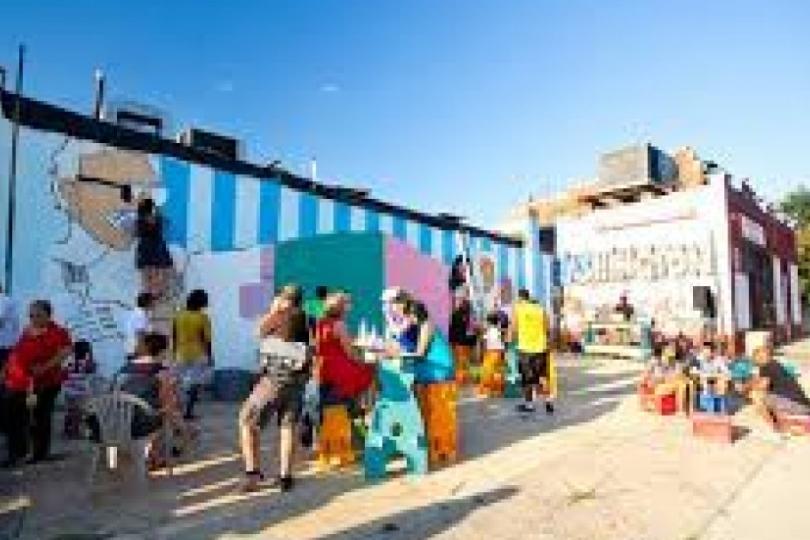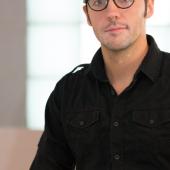BLOG: Seriously, What's With All the Creative Placemaking All of A Sudden?!
Editorial

The Last Connection
Before yours truly was asked to write this column, News and Notes was handled by Joshua Humphrey, who also ran a little podcast called Twin Cities Theater Connection. For several years, Josh interviewed theater artists from around the Twin Cities about their upcoming projects, their thoughts on he craft, and whatever else they wanted to talk about. Unfortunately for us, he decided to move up in the world and attend law school, which left the podcast on an indefinite hiatus since last year's big round up of the 2013 Fringe Festival.
For those of you left wondering about the fate of Theater Connection, I have good news and bad news. The good news is that, after a year of silence, the podcast is back with a new episode, another Fringe decompression featuring local reviewers hashing out the 2014 Festival. The bad news is that Humphrey announced at the beginning of it that it will be the last episode before TC Theater Connection closes up shop for good. The episode is in two parts, and part two has yet to come out, but when it does, the podcast will be done for good.
So, before we get started with News and Notes this week, let's all take a moment to thank Joshua Humphrey for his work and for his love of the Twin Cities theater scene. You did good, Josh. Good luck with the rest of law school, and may your mustache ever be brilliant.
We're All Placemakers Now
If you're in the arts or social services world, you've probably been inundated with the latest funding buzzword "Creative Placemaking". It's all the rage. How do we rebuild a shattered city like Detroit? Creative Placemaking! How do we get social justice and lower crime rates? Creative Placemaking! How do we make a city more "liveable"? You guessed it: Creative Placemaking! From what everyone's saying, Creative Placemaking is the answer to all of your woes. It cooks, cleans, educates your children with strong midwestern values, takes out the trash, gets rid of embarrassing odors and greets you at the door dressed in saran wrap and high heels.
Yep, sure is great. But what the hell is it?
Last week Minnesota Playlist round up artists Molly Van Avery, Molly Van Avery, and Charles Campbell to give their thoughts on what it is what it should do. Frankly, I'm still a little perplexed, because it seems like the definition has been left so purposely vague that it covers everything we were doing already.
And what does count as placemaking, anyway? The Hennepin Theatre Trust got $200,000 from the NEA's Our Town initiative to help with its effort to bring Broadway to Minneapolis, and it's touted as placemaking; but what happens when Brave New workshop invests in downtown on its own? Is that also placemaking? Or is it just a company investing in its future?
So, since I'm probably going to be filling out numerous grant applications in the immediate future that will feature "Creative Placemaking" prominently in their titles and/or descriptions, I guess I'm going to have to figure out what this all means.
The Rise
Let's start at the very beginning. (A very good place to start)
Back in 2001, a economics writer Richard Florida collected up a bunch of data for an article that determined that cities with a high "creativity index" do better economically. This article was expanded into the 2002 book Rise of the Creative Class, which was passionately embraced by the nonprofit arts world as proof that they do more than create artsy-fartsy puppet shows that few people watch and no one can understand. Rather than being byproducts of urbanization, highbrow art was necessary for cities to succeed.
Of course Florida's argument was more nuanced than this simplification; but simplification sells, and the lesson taken from Rise was "Step 1: Get more gays and artists; Step 2: ...something, something...; Step 3: PROFIT!"
Rocco's Modern Life
Flash forward a few years, and you land in 2009 (unless you set the controls on the time machine wrong, in which case you are desperately running from Morlocks), when Rocco Landesman wound up in the driver's seat of the NEA. Landesman stepped into the role after being a successful producer on Broadway, and immediately set about alienating the non-profit world he had been set to rule over. Landesman wanted to view the NEA throug the same market-driven supply/demand lens he had used on Broadway, and had a tendency to word his views rather, shall I say, "indelicately".
Poor Rocco. Right off the bat, nobody liked him, and all he wanted to do was this one little thing called radically overhauling the entire funding structure of the NEA so that it no longer directly funded artists. He launched a number of new initiatives, including ArtPlace, which was described as "a venture capital fund for the arts" in 2009. Unfortunately, they seemed to have forgotten that just a year before this, the real venture capitalists had helped run the nation's economy off a cliff. Landesman just couldn't seem to find the words to convince people that he wasn't a dismissive, combative, profit-hungry executive whose ultimate goal was to destroy the nonprofit arts sector.
But in a white paper for the NEA’s Mayors’ Institute on City Design surfaced that finally gave everyone (including Rocco), the words he needed: "Creative Placemaking". Soon after that paper made the rounds, ArtPlace stopped being described as "venture capital" and started being touted as "placemaking". Through initiatives like the NEA's Our Town grants, arts money was doled out through public/private partnerships and tagged for "revitalization" rather than "art".
Fun with Fungus
Like a forest, urban areas go through cycles of growth and decay. Look at New York's Soho neighborhood, which was once considered a terrible blight on the city and now is one of the most expensive neighborhoods in the metro. What connected those two radically different periods was the flowering of Soho as the "it" arts scene. In the classic narrative: artists, being poor, move into poor neighborhoods, make them hip, and then money follows.
Artists are considered the "occupiers of last resort". In the forest analogy, this makes them the fungus, eating up the dead wood and leaving behind fertilizer for the next round of trees. Basically, what I'm saying is that cities live off of artists' poop.
It's a classic cycle, but it's one that doesn't necessarily call for artists all the time (New York's Flower District, for example, was built up out of decaying docklands and warehouses by plant retailer), but now thanks to the ideas gleaned from Rise of the Creative Class and the mad scramble for money from the NEA, it's been raised to the status of legend. Apparently, any endemic problem in any city can now be cured by applying art.
But Does It Work?
Don't get me wrong. I'm not arguing that artists don't do anything for a city and that public art is not practically applicable to life. (Actually, if I had more time, I would try to convince you that it is, in fact, not practically applicable to day-to-day life, and that's kind of the point of art, but I'm not nearly high enough right now to to have that kind of intense discussion); but I do worry if we're not feverishly fetishizing "creative placemaking" before all the facts are in.
As many have pointed out, the NEA's own criteria for judging the succes of Creative Placemaking initiatives are pretty vague and tied to "indicators" that are not directly tied to the actual art. For instance, how do you know that any gain in the rate of home ownership is because your city got a creative placemaking grant to have an art car race and a do-it-yourself mural station? And, while we're looking at indicators, the ones that Richard Florida pulled together for his book are kind of suspect as well.
Nobody Really Knows
We're really only four years into this Creative Placemaking craze, so it will be a long time before anyone can pull together any actual real data points that mean anything; but when you step outside of the NEA's consistently rosy reports, you see less of a straight line between Placemaking efforts and measurable improvement on the NEA's own indicators. Philadelphia has had some success with Placemaking, but they still have neighborhoods that stubbornly refuse to "improve" no matter how many artists are poured into them. Milwaukee has seen similarly mixed results. Over at MN Artists, Sheila Regan pulled together a lot of information looking for the real effects of Creative Placemaking, and came up with a fascinating article, but no strong conclusion that will look good on an NEA report.
So, in the meantime, I'm think I'm pretty secure in saying that we don't really know what Creative Placemaking is, we don't have much proof that it does anything useful, but everyone's interested in it, and we all know one or two hip artists who say they totally understand it. My god... it sounds like I'm talking about art itself.
And that's how I realized that Rocco Landesman may have pulled off the greatest performance art piece in the history of mankind.




